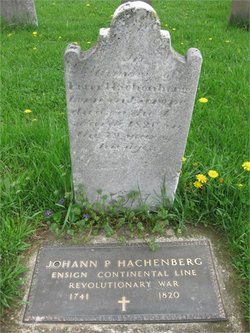Johann Peter HACHENBERG/HACKENBERG
SAR Patriot #:
P-172031
The following information was assembled from numerous sources and cannot be used directly as proof of Qualifying Service or Lineage.
It is considered a research aid and is intended to assist in locating sources that can be used as proof.
State of Service: PA
Qualifying Service: Ensign / Patriotic Service
DAR #: A048849
Birth: 10 Apr 1741 Hachenberg / / Germany
Death: 04 Mar 1820 Middleburgh / Union / PA
Qualifying Service Description:
- 1Sgt., Capt Valentine Opp, Col Hart, Flying Camp
- Comissioned Ensign and Batt. Quartermaster
- Ens., Col Baxter, Continential Army Flying Camp, PA Militia, 1778
- NSDAR cites PRISONER AT LONG ISLAND
Additional References:
- DAR cites
- PA Archives
- 2nd Series, Vol 15, pg 649, 652
- 6th Series
- Vol 1, pg 2
- Vol 2, pg 880, 884
- Vol 24, pg 757
- PA Archives
Spouse: Anna/Annie Elizabeth Siphers/Seyfout/Seypart/Seyfoot
Children: Peter Jr; Michael; John;
Members Who Share This Ancestor
| Date Approved | Society | ACN | SAR Member Info | Lineage via Child | View Application Detail | |
|---|---|---|---|---|---|---|
| 1969-09-09 | PA | Unassigned | Roy Hackenberg (99185) | Peter | ||
| 1986-03-18 | PA | 228037 | Carl Alphus Keyser (127327) | Peter | ||
| 1988-03-21 | PA | Unassigned | Herbert K Zearfoss (109917) | Peter | ||
| 1989-08-17 | OH | 219860 | Donald Weichel Moyer (133433) | John | ||
| 1990-07-25 | PA | 217957 | Max Stewart Hackenberg (135357) | Peter | ||
| 1992-03-23 | PA | Unassigned | David Stewart Hackenberg (138636) | Peter | ||
| 2000-07-27 | KS | 7120 | Richard Russell Brown (154250) | Peter | ||
| 2003-03-17 | OH | 15437 | Robert Hackenberg (159916) | Michael | ||
| 2006-11-13 | OH | 26916 | Bryan Patrick Blake (168120) | John | ||
| 2008-02-25 | AZ | 30616 | Scott Richard Driver (171138) | Michael | ||
| 2009-03-26 | OH | 35402 | Bradley William Blake (173616) | John | ||
| 2009-12-03 | IN | 36804 | Douglas Alton Adams (161984) | John | ||
| 2017-12-08 | IL | 76957 | Charles Darwin Dobias (168423) | Michael |
Location:
Freeburg / Snyder / PA / USA
Find A Grave Cemetery #:
Marker Type:
Military, Upright, Patriot Contemporary
SAR Grave Dedication Date:
Comments:
Image provided with permission from Memories4Ever, Find-a-Grave member # 47173142
Directions to Cemetery / Gravesite:
